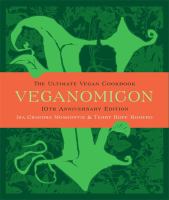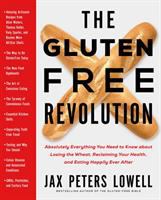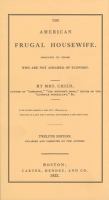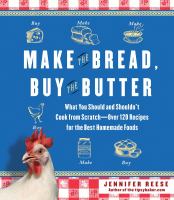Sat, 03/27/2021 - 12:00am

When it’s cold outside, or you can’t leave the house due to a raging pandemic, or you’re just plain bored, looking through a cookbook for just the right recipe and getting to work in the kitchen or planning a future meal can be just the ticket--after all, you can only knit so many shawls, show off your cat in a Zoom session so many times, or keep making TikTok videos of your family performing everything from Hamilton to Beyonce’s Formation video before they all rebel, but people always need to eat, and then eat again a few hours later (not to mention, you won’t need to order extra storage bins online to store all those shawls). I collect cookbooks and have the overflowing six-foot bookcase to prove it, and here are a few that I’ve found helpful, entertaining, or both.
 Like many people, I have a number of vegan friends who occasionally require feeding, and vegan recipes are often both cheaper and deliver maximum nutrition than dishes call for animal products. One of the biggest names in vegan cuisine is Isa Chandra Moskowitz, who started with an NYC cable-access show called The Post-Punk Vegan, moved on to her first cookbook, Vegan With a Vengeance, and is now the queen of Gen-X inspired vegan cookbooks. Veganomicon, co-written with her good friend Terry Hope Romero, is an old-fashioned, all-purpose vegan cookbook that covers just about anything you might want to make, and does it with recipes that are simple, substantial, and delicious. Think of it as the vegan Betty Crocker or Joy of Cooking, but with a wiseass attitude that makes me laugh while paging through it. Not only is it fun to read, but everything I’ve made from this cookbook has been delicious, and I can’t say that about a lot of cookbooks. Try the Tomato-Rice Soup with Roasted Garlic and Navy Beans--you’ll have plenty of leftovers for the rest of the week!
Like many people, I have a number of vegan friends who occasionally require feeding, and vegan recipes are often both cheaper and deliver maximum nutrition than dishes call for animal products. One of the biggest names in vegan cuisine is Isa Chandra Moskowitz, who started with an NYC cable-access show called The Post-Punk Vegan, moved on to her first cookbook, Vegan With a Vengeance, and is now the queen of Gen-X inspired vegan cookbooks. Veganomicon, co-written with her good friend Terry Hope Romero, is an old-fashioned, all-purpose vegan cookbook that covers just about anything you might want to make, and does it with recipes that are simple, substantial, and delicious. Think of it as the vegan Betty Crocker or Joy of Cooking, but with a wiseass attitude that makes me laugh while paging through it. Not only is it fun to read, but everything I’ve made from this cookbook has been delicious, and I can’t say that about a lot of cookbooks. Try the Tomato-Rice Soup with Roasted Garlic and Navy Beans--you’ll have plenty of leftovers for the rest of the week!
 I found out I have celiac disease--meaning that I can’t eat wheat, rye, barley, or anything with gluten in it--just over three years ago, and I strongly recommend Jax Peters Lowell’s The Gluten-Free Revolution to any one with celiac, or who cares about someone else who has it. Not a cookbook per se (although there are dozens of recipes from some of America’s leading chefs), but a guide to help the bewildered celiac through life, it covers emotional, medical, and social/community issues that you need to know about, not to mention things you never dreamed about. (Example: if you’re a celiac, kissing someone who eats gluten can result in cross-contamination and nasty intestinal symptoms.) From how to order in a restaurant and not be “glutened”, to dealing with in-laws who don’t believe your child really has celiac, to making sure your prescriptions and personal-care products are gluten-free, to engaging in social and political action for celiacs and others with allergies, this book has it all, and someday, when I can actually spend time with friends again, I will make that Spiced Carrot Cake with Sweet Mascarpone Frosting!
I found out I have celiac disease--meaning that I can’t eat wheat, rye, barley, or anything with gluten in it--just over three years ago, and I strongly recommend Jax Peters Lowell’s The Gluten-Free Revolution to any one with celiac, or who cares about someone else who has it. Not a cookbook per se (although there are dozens of recipes from some of America’s leading chefs), but a guide to help the bewildered celiac through life, it covers emotional, medical, and social/community issues that you need to know about, not to mention things you never dreamed about. (Example: if you’re a celiac, kissing someone who eats gluten can result in cross-contamination and nasty intestinal symptoms.) From how to order in a restaurant and not be “glutened”, to dealing with in-laws who don’t believe your child really has celiac, to making sure your prescriptions and personal-care products are gluten-free, to engaging in social and political action for celiacs and others with allergies, this book has it all, and someday, when I can actually spend time with friends again, I will make that Spiced Carrot Cake with Sweet Mascarpone Frosting!
 Lydia Maria Child is known today as the author of “Over the River and Through the Woods,” (she was born in nearby Medford, and Tufts currently owns her grandparents’ house), but during her lifetime she was best known as an abolitionist who also supported women’s and Native American’s rights, and who, along with her husband David, sheltered runaway slaves on their way to Canada at their home in Wayland. Although her writings range from political tracts to novels, poetry, and a child-rearing manual, her best-known and best-selling book was The American Frugal Housewife. With its subtitle, “Dedicated to Those Who Are Not Ashamed of Economy,” it’s more a general housekeeping manual than a cookbook, although it does contain a number of recipes considered suitable for working-class and lower-middle-class families. Unless you already have experience adapting older recipes without specific measurements, you may not want to recreate the baked goods, and I suspect many of the other dishes might not be to modern tastes, either. (“Corn should be boiled from twenty minutes to sixty, according to age.”) Still, while you might not want to cook from them, historical cookbooks and housekeeping manuals offer both valuable insight into how people lived, or wanted to live (even today, cookbooks are often aspirational in nature) during a particular time and place--in this case, America in the early 19th century--and sometimes good advice that still holds true today. For every quote such as “[preserves] are unhealthy, expensive, and useless to those who are well,” or “A rind of pork bound upon a wound occasioned by a needle, pin, or nail, prevents lockjaw,” there is one such as “If you are about to furnish a house, do not spend all your money....you will find you have purchased many things you do not want, and have no means left to get many things which you do want,” “Not one valuable friend will be gained by living beyond your means,” and “If men would have women economical, they must be so themselves”--common sense advice as true now as it was in 1833!
Lydia Maria Child is known today as the author of “Over the River and Through the Woods,” (she was born in nearby Medford, and Tufts currently owns her grandparents’ house), but during her lifetime she was best known as an abolitionist who also supported women’s and Native American’s rights, and who, along with her husband David, sheltered runaway slaves on their way to Canada at their home in Wayland. Although her writings range from political tracts to novels, poetry, and a child-rearing manual, her best-known and best-selling book was The American Frugal Housewife. With its subtitle, “Dedicated to Those Who Are Not Ashamed of Economy,” it’s more a general housekeeping manual than a cookbook, although it does contain a number of recipes considered suitable for working-class and lower-middle-class families. Unless you already have experience adapting older recipes without specific measurements, you may not want to recreate the baked goods, and I suspect many of the other dishes might not be to modern tastes, either. (“Corn should be boiled from twenty minutes to sixty, according to age.”) Still, while you might not want to cook from them, historical cookbooks and housekeeping manuals offer both valuable insight into how people lived, or wanted to live (even today, cookbooks are often aspirational in nature) during a particular time and place--in this case, America in the early 19th century--and sometimes good advice that still holds true today. For every quote such as “[preserves] are unhealthy, expensive, and useless to those who are well,” or “A rind of pork bound upon a wound occasioned by a needle, pin, or nail, prevents lockjaw,” there is one such as “If you are about to furnish a house, do not spend all your money....you will find you have purchased many things you do not want, and have no means left to get many things which you do want,” “Not one valuable friend will be gained by living beyond your means,” and “If men would have women economical, they must be so themselves”--common sense advice as true now as it was in 1833!
 In recent years, there’s been a lot of emphasis on making as much of what you eat as possible (unless you can afford to buy from artisanal provisioners), and that to do less means you don’t care about the quality of your food. Save your time and energy, folks: Jennfer Reese, the author of The Tipsy Baker blog, has been there, done (most of) that, and lived to tell the tale in Make The Bread, Buy The Butter: What You Should and Shouldn’t Do From Scratch. Jennifer knows whereof she speaks, believe me--this is a woman who has made her own salt pork (make it), mozzarella cheese (try it at least once), and raised goats for milk and chickens for eggs (do it only if you enjoy having the animals around, although backyard eggs are fresher). She’s also spent time comparing many of the items we regularly buy at the supermarket to their homemade version: from bread, peanut butter, yogurt, pizza, and chicken soup (make them), to butter, hamburger buns, sashimi, prosciutto, and maraschino cherries (buy them). There are over 120 recipes for almost everything mentioned above, with a few exceptions (she really doesn’t recommend making maraschino cherries), along with breakfast items, desserts, main dishes, baked goods, restaurant favorites, her mother’s orange-apricot preserves, and alternatives to Costco lasagna for dinner parties (I really want to try the Vadouvan Mac ‘n’ Cheese, although finding the vadouvan spice blend is turning out to be harder than I thought). It’s a terrific cookbook containing recipes for basics that you won’t find anywhere else, and Jennifer’s humorous tales of the kitchen and her family life makes for entertaining reading, even if you don’t try any of the recipes.
In recent years, there’s been a lot of emphasis on making as much of what you eat as possible (unless you can afford to buy from artisanal provisioners), and that to do less means you don’t care about the quality of your food. Save your time and energy, folks: Jennfer Reese, the author of The Tipsy Baker blog, has been there, done (most of) that, and lived to tell the tale in Make The Bread, Buy The Butter: What You Should and Shouldn’t Do From Scratch. Jennifer knows whereof she speaks, believe me--this is a woman who has made her own salt pork (make it), mozzarella cheese (try it at least once), and raised goats for milk and chickens for eggs (do it only if you enjoy having the animals around, although backyard eggs are fresher). She’s also spent time comparing many of the items we regularly buy at the supermarket to their homemade version: from bread, peanut butter, yogurt, pizza, and chicken soup (make them), to butter, hamburger buns, sashimi, prosciutto, and maraschino cherries (buy them). There are over 120 recipes for almost everything mentioned above, with a few exceptions (she really doesn’t recommend making maraschino cherries), along with breakfast items, desserts, main dishes, baked goods, restaurant favorites, her mother’s orange-apricot preserves, and alternatives to Costco lasagna for dinner parties (I really want to try the Vadouvan Mac ‘n’ Cheese, although finding the vadouvan spice blend is turning out to be harder than I thought). It’s a terrific cookbook containing recipes for basics that you won’t find anywhere else, and Jennifer’s humorous tales of the kitchen and her family life makes for entertaining reading, even if you don’t try any of the recipes.
--Robin Moore, Senior Substitute Librarian

Add new comment